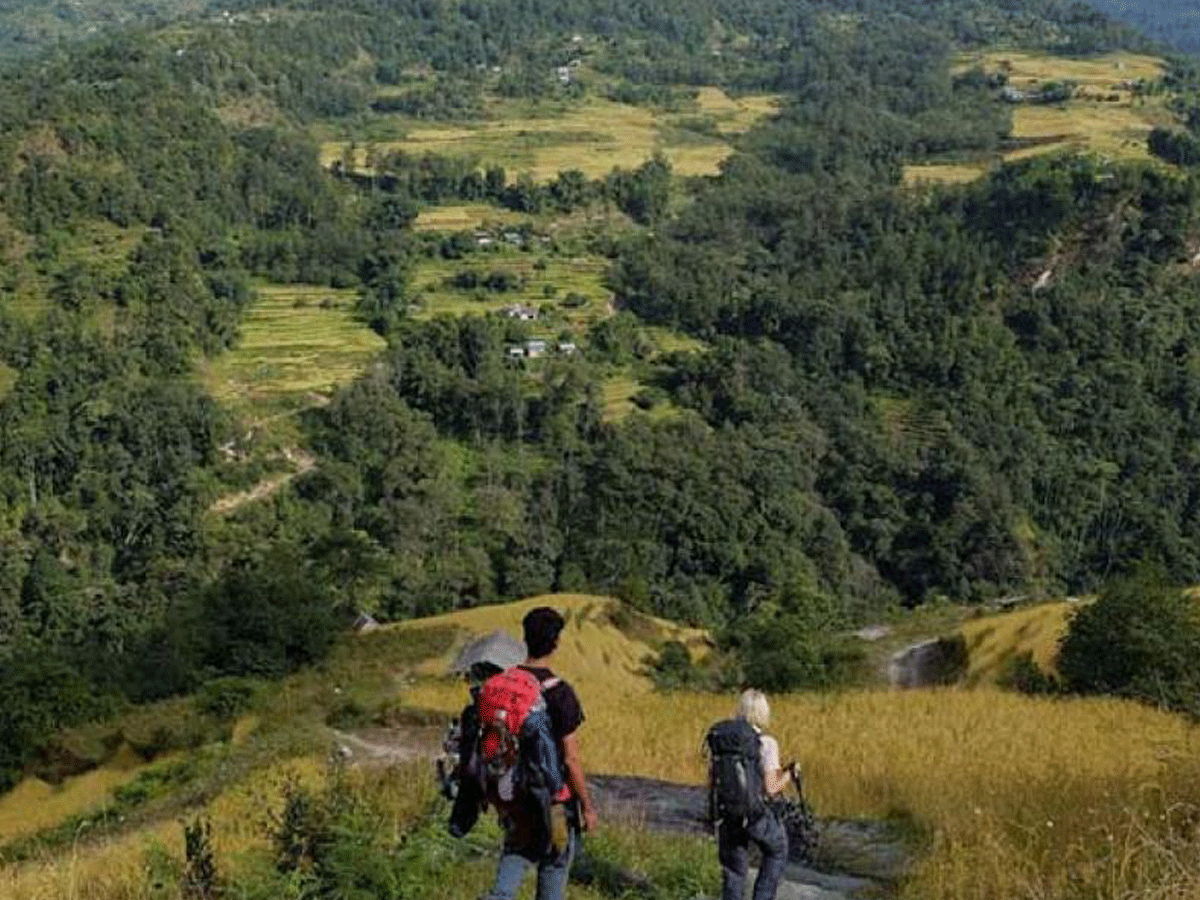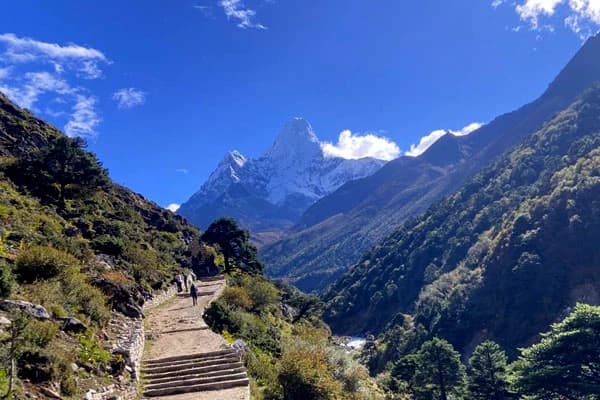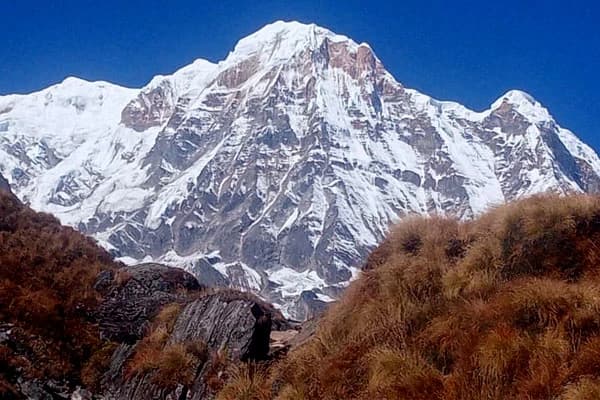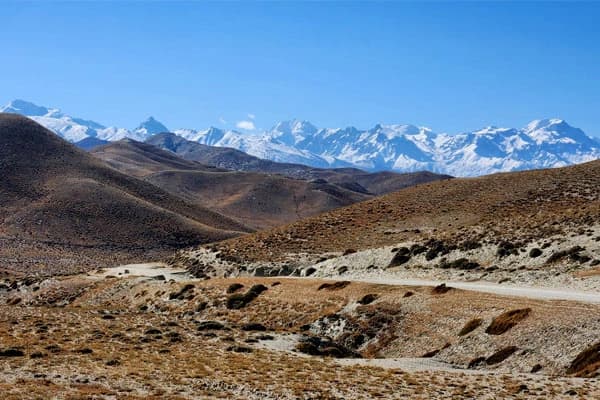Why Is Kanchenjunga Trek Challenging?
The Trek difficulty level system features three categories, including Easy to Moderate then Difficult which Kanchenjunga Trek falls under. The completion of this trek demands about 20 days of continuous trekking and throughout each day, you need to cover many hours of climbing and descending steep hills.The mountain climate changes rapidly throughout the day so the weather can create harsh conditions by hitting extreme cold temperatures and producing windy conditions and wet precipitation like rain and snow. This makes walking harder and tests your endurance.
The oxygen levels decrease steadily with each increase in elevation, where altitude sickness represents the health issue that may develop, causing more difficulties. People need to be aware that accommodation facilities and dining are extremely limited throughout the Mt Kanchenjunga Trek route because it falls in the remote and distant restricted area where simple tea houses serve basic amenities. Here is a complete guide to Mount Kanchenjunga Trek more in depth that offers the tips to tackle challenges with ease.
What factors make the Kanchenjunga Trek Difficult?
Out of all treks in Nepal, the Mount Kanchenjunga Trek ranks as one of the highest demanding paths because it presents numerous obstacles that enhance the overall hiking complexity. This segment outlines major components of Kanchenjunga Trek's challenging nature, allowing you to understand the settings and plan adequately.

High Altitudes
Through the Kanchenjunga Trek, you can reach extremely elevated points and the highest altitude of the trek exists at Pangpema which sits at 5,143 meters (16,873 feet) above sea level. The depletion of oxygen with increasing elevation produces a thin atmospheric condition that makes breathing harder and drains your energy faster. And the most concerning thing is the risk of altitude sickness which can cause severe health issues if not treated well. So make sure to ascend gradually!
Long Distance And Duration
Kanchenjunga Trekking journey extends over a significantly longer duration than the Poon Hill orLangtang Valley Trek routes which are shorter. Your entire walking adventure spans 190 kilometers (112 miles) while requiring between 18 to 22 days for most individuals to complete, while your trekking days will consist of 5 to 7 hours of uphill and downhill trail walking. Yep, it is not easy! The lengthy journey challenges both your physical strength and mental endurance since you must remain patient throughout an extended period of difficult trekking.
Remote And Steep Terrain
Trail paths during the Kanchenjunga Trek lead to extremely isolated locations where the remote area contains a small population while health assistance requires distant access if emergency assistance is required. The hiking terrain features numerous steep slopes that traverse high elevations between hills and includes thin pathways that expose risky drop-offs on one side. Trekking through this area means spending many hours without encountering other people since settlements are sparse. It's mostly just you in the remote trails! When compared to trekking in popular regions, the Kanchenjunga Trek requires advanced skills because of its demanding pathways.

Snowy Section
Several sections of the Kanchenjunga Trekking route develop snow and ice cover during specific times of the year, where lack of trail visibility due to snowfall exposes you to the risk of getting lost, especially if you do not have a guide. The most elevated locations of the trek such as base camps, tend to contain snowy areas which result in extreme cold temperatures, even freezing!. The snowy terrain creates major obstacles in the trek therefore you must plan your visit during specific seasonal periods.
Limited Accessibility
Well, here’s a little heads up: accessing the starting point of the Kanchenjunga Trek is not easy! To begin the journey, you must first reach Bhadrapur or Suketar before completing a multiple-hour, bumpy jeep journey to Kanyam then finally to Taplejung. After beginning your Kanchenjunga Trail journey, you will find limited options for accommodation and dining services in the limited teahouses along the route. And above all, contacting medical assistance becomes difficult since the facilities are located at a great distance so it can take a long time to reach you. You need full preparation along with the essential items for this restricted area with limited accessibility to ensure your safety.
Weather And Climatic Conditions
Rapid weather changes frequently occur throughout the Kanchenjunga region so you never know what will come next. he sun shines brightly until afternoon, when the area transitions to raining or snowing conditions. The recommended periods for trekking are during the spring months (March to May) and the autumn season (September to November). During the summer, you will encounter heavy rainstorms and leeches along the hiking paths while winter has harsh temperatures along with overwhelming snowfall which covers up all walking paths. The temperature gets dangerously cold during nighttime even when the season is good because high camps experience freezing conditions. It’s always cold in the Himalayas! Hard winds will blow with powerful gusts to chill your entire body while sudden fog and cloud cover quickly reduce the visibility.
Kanchenjunga Circuit Trek Vs Kanchenjunga Base Camp Trek
Planning a Trek to Kanchenjunga? Kanchenjunga Circuit Trek and the Kanchenjunga Base Camp Trek are the options. You need to understand different trek options according to Kanchenjunga Trek difficulty levels while determining which sights you want to experience.
Route and distance
The Kanchenjunga Circuit Trek requires the longest time to finish its 210-kilometer (130-mile) journey which takes between 22 and 25 days to complete. The trek circles the entire Kanchenjunga massif as it moves in a large loop as starting in Taplejung, you will journey through Ghunsa village toward the Mirgin La Pass while visiting North Base Camp, South Base Camp, and finally returning. The trek explores various valleys while passing through multiple mountains which allows you to understand Kanchenjunga from all directions.
The Kanchenjunga Base Camp Trek spans between 80 to 112 miles (130 to 180 kilometers), depending on base camp selection, requiring 16 to 20 days for completion. Both trekking routes follow steep terrains and rock sections which require between 5-7 hours of daily walking duration. The Circuit Trek leads to higher elevation points than the Kanchenjunga Trek while having additional high mountain passes that elevate its level of difficulty.
Types of Kanchenjunga Base Camp Trek
You have two primary routes to reach the foot of Kanchenjunga. Each route consists of distinct features that will help you determine the best adventure destination according to your interests. Here is a brief introduction to each route:
Kanchenjunga North Base Camp Trek: It leads trekkers to Pangpema at 5,143 meters to observe Kanchenjunga's enormous north-facing peak. The trek begins in Taplejung, heading to the Tibetan Ghunsa settlement then progresses to Kambachen for the final stop at Pangpema base. You need 16 to 18 days to finish this journey that reveals stunning views of both Jannu Peak and Kanchenjunga.
Kanchenjunga South Base Camp Trek: The Kanchenjunga South Base Camp Trek allows visitors to reach 4,730-meter-high Oktang Base Camp for panoramic views of the mighty southern face. The Yalung Valley trek begins at Taplejung before entering Sherpa and Rai settlements on its way to the main destination. The main stopping points on this route are Torongtan followed by Tseram and then Ramche before reaching Oktang. The 16-18 day path provides a less common trekking experience than its northern counterpart because it remains off the beaten path. The base camp allows for viewing the magnificent south face of Kanchenjunga and the surrounding peaks of Kabru and others.
How to overcome the challenges and ace it with ease?
Yes, the Kanchenjunga Trek presents a difficult challenge yet proper planning allows you to complete it successfully. Following this list of tips will help you overcome the Kanchenjunga Trek Difficulty levels for improved travel experiences.
Physical preparation
You need your body to be ready for enduring the harsh terrain together with extended days during the Kanchenjunga Trek. The following methods represent essential preparation methods:
- Begin an exercise schedule at least three months before the trek while focusing on cardio exercises which include running, cycling or swimming.
- Hike with a backpack on weekends while building up distances and height
- Stair climbing exercises will build the muscle strength required for climbing hills.
- Perform planks and sit-ups which strengthen your core muscles
- Walk a distance of 10-15 kilometers at least once per week during your final trek preparation month.
Mental Preparation
- Your mind will face just as many challenges as your body does during the Kanchenjunga Trekking Trail. Here are some essential tips:
- Before the trek begins, research about daily expectations to eliminate uncertainties.
- Meditation or deep breathing practice will help you stay composed when you encounter challenging sections of the trek.
- Focus on daily objectives, rather than the final destination
- Consult with individuals who have finished the trek to obtain knowledge through their stories and increase self-confidence levels.
- Keep a positive mind! Accept the challenges as part of the whole experience
Medical Consideration
Remember, your health is the top priority! Before beginning the Trek to Kanjanjunga, you need to obtain medical approval from your physician, especially when you have pre-existing health conditions. Before your trek, create a personal medical kit containing painkillers and anti-altitude sickness drugs along with bandages, an antiseptic cream, blister solutions, cold remedies and throat lozenges, anti-diarrhea medication and any medications you need for daily use. Learning the methods to prevent altitude sickness is vital because it remains the most dangerous health risk beyond elevations of 3,000 meters. The first warning signs of altitude sickness include headache together with dizziness, nausea and difficulty sleeping so tell your guide right away if you experience these symptoms.
Hike Along with An Experienced Guide
The best solution for conquering the Kanchenjunga Trek Difficulty relies on working with an experienced guide, which is mandatory. They are like your trekking superheroes! A local guide has expertise about trail paths along with knowledge about weather conditions and shelter locations during bad weather. The communication skills of guides enable them to interact with residents because most inhabitants in this secluded region do not understand English.

A guide enables your body to acclimate to altitude changes by applying proper pacing and quickly detects early warning signs of altitude sickness. They have basic first-aid knowledge to aid you in injuries. With their local knowledge, guides can direct you to the most excellent tea houses while arranging everything from food to lodging. Hiring a guide is the best decision to complete the trek in Kanchenjunga safely.
Top 10 training tips for the Kanchenjunga Trekking
- Start your training schedule 3 to 4 months prior to the Kanchenjunga trek. You should concentrate on cardiovascular exercises which include running, cycling and swimming to develop strength for your heart muscles and lungs.
- When training for hiking use the exact backpack that you will use during your upcoming Kanchenjunga trekking adventure. Begin with explorations of 2-3 hours that involve carrying a load weighing 5-7 kg and evolve to longer hikes with additional weight added.
- Your workout routine must include squats along with lunges and step-ups and calf raises performed regularly every week. Do three sets of 15 to 20 repetitions each exercise twice to three times every week.
- Your ability to maintain balance on rough terrain along with proper back support during backpack use depends on the strength of your core (stomach and back muscles). Train by doing planks combined with push-ups along with dumbbell rows.
- Proper breathing remains vital when climbing to elevated regions since the air becomes thinner. Perform deep breaths starting with nose inhalation followed by total lung expansion then complete mouth exhale. Do this for 5-10 minutes daily.
- Training exercises in outdoor environments best prepare you for rain, wind, hot and cold temperatures. Training exposes your body to adapt while you learn how different clothing works for each environment.
- A Kanchenjunga trek demands endurance more than speed skills. Train for longer periods of exercise duration rather than training at different intensities during your preparation.
- Train with a downward incline by locating steep hills or using a treadmill adjusted to a sloping descent. Build strong quadriceps since they reduce impact during downhill descents by adding wall sits exercises.
- Doing yoga tree pose and warrior pose along with one-legged tooth brushing can improve your balance abilities. Perform ankle rotations together with heel walks and toe walks to develop ankle strength.
- You should perform stair climbing exercises at high resistance levels or engage in high-intensity interval training sessions which will cause brief oxygen deprivation to your muscles. Including "hypoxic training" involves performing 5-10 deep inhalations followed by exercise under controlled breathlessness for brief intervals.
Essential Gears And Equipment
Technical Gear for High Passes
- Trekking poles serve as stability tools while navigating steep slopes and they help minimize knee pain.
- Microspikes along with crampons serve as traction tools for icy conditions
- Quality headlamp with spare batteries for early starts and unexpected delays
Snowy Sections
- A four-season sleeping bag able to sustain freezing temperatures below -15°C during nights at higher camps
- Wetproof insulated gloves in snowy environments.
- Polarized sunglasses serve as eye protection against snow reflected glare at extreme heights above sea level.
Health Essentials
- Diamox tablets serve as protection against altitude sickness when hiking above 3000 meters.
- Water purification tablets or a reliable filter system for safe drinking water
- Comprehensive first aid kit with blister treatment, bandages, antiseptic, and pain relievers
Communication
- Local NTC or Ncell SIM
- Satellite phone for emergency communication in this remote region
- A compact notebook combined with a pen functions as a tool for conveying messages to local people who speak limited English.
Clothing and Footwear
- Take ankle-supporting waterproof boots that have been properly broken in for challenging rocky paths.
- Base layers designed to wick moisture help control temperature
- A down jacket acts as an essential layer for preventing heat loss during the low nighttime temperatures
- Trekking pants with quick-dry fabric also have adjustable features that help handle different temperatures.
- Wear multiple thermal socks to prevent foot blisters
Other Essentials
- Durable, waterproof backpack cover for unexpected downpours
- The quick-drying lightweight towel functions as a multi-use item that requires minimal storage area
- A ziplock bag serves to protect electronic devices and vital documents from water damage.
- 2-3 liter reusable water bottles
- Sunscreen, lip balms and moisturiser to protect the skin
What Is The Risk Of Altitude Sickness during the trek to the Kanchenjunga region?
The big question remains: altitude sickness risk during the Kanchenjunga Trek? High altitudes expose you to thin air conditions, where you may develop altitude sickness because the altitude exceeds 5,000 meters above sea level. So be careful, altitude sickness also known as “Acute Mountain Sickness (AMS)”, is always there! We need to understand this problem while learning effective safety methods.
Acclimatization
Acclimatization enables your body to adapt properly to high-altitude regions with reduced atmospheric oxygen availability and the most effective method to adapt to high elevation is? Gradual ascent. According to the climbing rule, you should gain elevation during the daytime but return to lower elevations for sleeping. The recommended Kanchenjunga Himal Itinerary features Ghunsa as an acclimatization day alongside Kambachen.
People typically adapt well to daily elevations that do not exceed 300 to 500 meters. Anything more than that can pose a threat of AMS, so you need to be extra careful!
Symptoms of altitude sickness
- Headache
- Nausea and vomiting
- Dizziness
- Fatigue
- Loss of appetite
- Shortness of breath
- Trouble sleeping
Preventive guidelines
- Don't rush up the mountain so walk at a steady pace which allows you to adjust to reduced oxygen levels. It is best not to gain over 500 meters in altitude each day.
- Daytime hiking leads you higher while you should aim to sleep in a lower elevation area because your body will adapt more efficiently to the environmental changes.
- Your body loses a lot of water because the mountain region has extremely dry conditions and you walk for hours so every day, make sure to drink 3-4 liters of water.
- Devote an additional day for acclimatization because your body requires time to adapt to the thin air conditions.
- Report any headache, dizziness or stomach sickness immediately because these are warning signs of altitude sickness. Inform your guide or companions immediately to assist you.
- The heart will race while breathing becomes harder when people exceed 3000 meters, so they should completely avoid smoking and alcohol intake including local alcoholic beverages.
- Stop at every location to monitor your oxygen level with an oximeter and notify your guide about discomfort and any oxygen readings below average.
Logistics and Permits:
You need to acquire two permits to enter the restricted Kanchenjunga Region in Nepal which can only be possible if you are trekking through a registered trekking agency like Destination Himalaya Treks and Expedition must trek along with at least one other person and that doesn’t include the guide.
- Kanchenjunga Restricted Area Permit: USD 20$ ( NPR 2000)
- Kanchenjunga Conservation Area Permit: USD 30$ ( NPR 3000)
Limited accommodation and food options
To be completely honest with you, there are not many lodging facilities throughout the Mount Kanchenjunga Trek route and the food choices are extremely limited. Tiny tea houses provide basic accommodations for overnight stays, where each room is tiny with a shared bathroom. Night temperatures drop low because the rooms have no heating system!
The meals served are basic and straightforward and mostly consist of Dalbhat and noodles. Let me tell you, the small tea houses sometimes lack food supplies because of their distance from urban centers and shopping districts so you should keep emergency snacks in your backpack at all times. A pro tip: The walking distance between tea houses requires careful planning because you could find yourself sleeping in the open night sky if you underestimate your route.
Is Kanchenjunga Trek Dangerous?
So is it really dangerous to trek to Kanchenjunga? The terrain features dramatic inclines that drop straight down on particular sides with rocky and uneven trails. Unpredictable changes in weather conditions result in powerful wind, rain or snow which create difficult trekking conditions.
And not to forget, high altitude elevation points present a risk of developing serious altitude sickness unless you receive proper treatment. The location of this trek exists in a distant region which makes access to medical facilities highly delayed.
But hey, I dont mean to discourage you. With careful planning and following directions from a good guide and walking at a steady pace while adhering to safety protocols the Kanchenjunga Trek presents minimal risk and full enjoyment.
Conclusion: Is Kanchenjunga Trek right for you?
Do you consider the Kanchenjunga Trek suitable for your adventures? The decision depends on what type of exploration you wish to experience. You should choose this adventure if you enjoy extended outdoor nature stays at teahouses and want to witness a top-world mountain peak.
Walking days throughout the trek are challenging since the altitude reaches high elevations thus, former hiking experience, preparation and physical fitness enhance your chances of success.
You will find few tourists in the Kanchenjunga Trail compared to the number of tourists found in other trekking routes so you stumble upon your personal Himalayan paradise just like that!
Finally Thoughts
Do not worry if the Kanchenjunga trek difficulty seems beyond your capabilities for a first-time adventure. Nepal presents various great trekking opportunities that are suitable for those starting out.
First-time adventurers love the Poon Hill Trek,Mardi Himal and Langtang Valley Trek because of its short duration and easy trail. Are you looking for something which received worldwide fame? Everest Base Camp presents a demanding trekking experience yet beginners with adequate preparation can manage it while those seeking a quieter path should consider the Three Passes Trek.
The best part? All these routes operate without requiring special restricted permits which Kanchenjunga does. You will need only obtain the traditional trekking permit to begin your journey on the trails. Pretty sweet, right? Get your perfect adventure now! Contact us.







